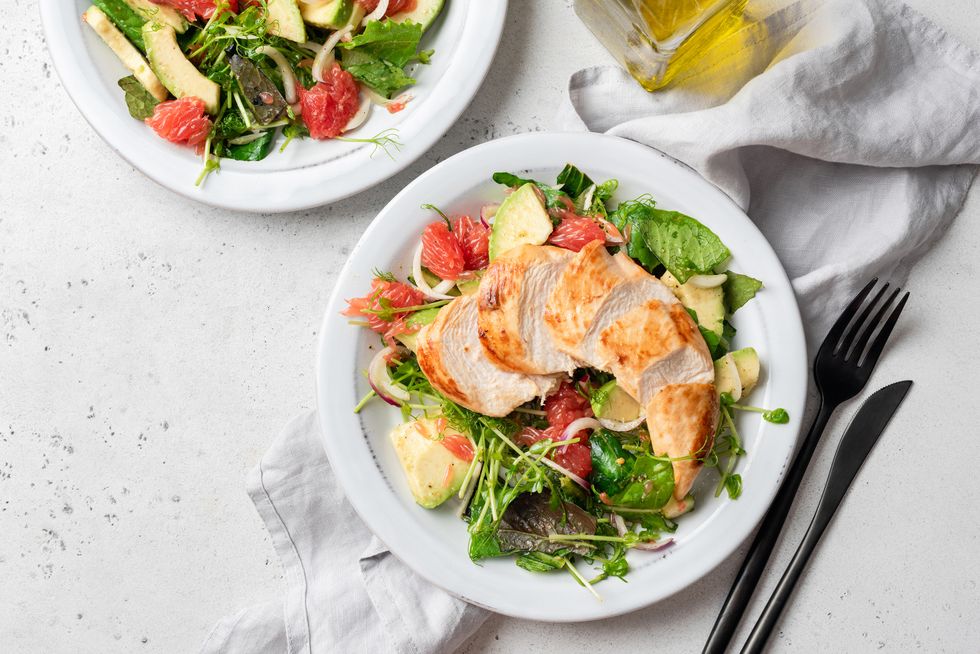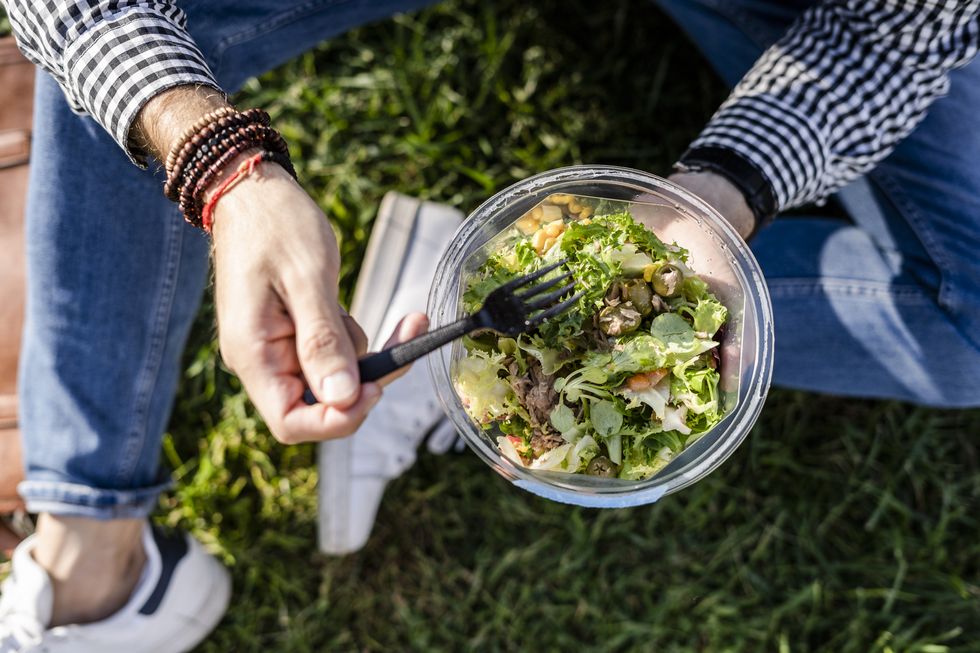PROTEIN HERE, PROTEIN there, protein… everywhere.
“It seems as though almost everyone is talking about a high-protein diet, and the food manufacturers are responding to the trend,” says Maelee Wells Sutton, R.D.N., C.P.T.
With the nutrients load of health benefits, there seems to be a good reason for society’s collective obsession with protein. That benefit is universal, regardless of who you are and what your goals are. It’s vital to muscle building. It’s great for individuals striving to lose weight, as eating a diet with above FDA-recommended protein intake has been seen to increase loss of fat mass and decrease loss of muscle mass. Its even been associated with a reduction of various aging measurements. And that’s just the tip of the iceberg.
Ahead, learn more about the benefits of a high-protein diet and savvy ways to add more protein to your plate.
What exactly is a high-protein diet?
Protein is found in your muscles, bones, skin, hair, and other parts of your body, according to the Harvard T.H. Chan School of Public Health. It helps fuel several chemical reactions in your body, including powering the hemoglobin that moves oxygen in your blood.
So, consuming protein is good for you, but defining what’s considered “high protein” is tricky, Kris Sollid, R.D., senior director of nutrition communications at IFIC, says.

Arx0nt//Getty Images
“For example, some protein recommendations are based on the percentage of calories in a diet that comes from protein,” he says. “Other protein recommendations are based on body weight.”
Adults should get at least 0.8 grams of protein for every kilogram of body weight each day—which equates to about 7 grams per 20 pounds of body weight.
Consuming any amount over that recommendation would be considered a high-protein diet, Leah Silberman, R.D., a registered dietitian at Medical Offices of Manhattan, says.
Here’s what a high-protein diet can look like:
High Protein Based on Body Weight
One high-protein rule for the average person is 1.2 grams or more of protein per kilogram of body weight, Sollid says. If you do intense workouts and weight training, you could up your protein to 1.75 grams.
If you opt for 1.75 grams of protein per kilogram of body weight a day, that would equal:
About 125 grams per day for a 154-pound personAbout 160 grams per day for a 200-pound person
High Protein Based on Percent of Calories
Protein intake can vary depending on your caloric needs, which are influenced by your age, size, fitness level, and other factors, Sollid says.
Another way to increase protein is to make protein-rich foods a significant portion of your daily calories. For instance, Sollid says high protein could be defined as more than 22 percent of your total daily calories. Here are some examples:
About 80 grams of protein per day for a 1,500-calorie dietAround 110 grams of protein per day for a 2,000-calorie dietAround 140 grams of protein per day for a 2,500-calorie dietAround 135 grams of protein per day for a 3,000-calorie diet
What are the benefits of protein?
Protein has been shown to help with weight loss and weight management because it makes you feel full for longer. One study found that when overweight women increased their protein intake from 15 percent to 30 percent, they ate about 400 fewer calories a day.

Tetra Images//Getty Images
Research also shows that eating more protein helps you maintain muscle mass and build muscles and strength during strength training.
Protein has potential metabolism-boosting effects. It could also help lower your blood pressure and promotes bone health.
Can you eat too much protein?
While you can eat too much of anything, Sollid says most healthy people don’t need to worry about consuming too much protein. But if you have health problems, like kidney disease, you need to monitor your protein intake.
There’s no official “threshold for too much protein,” since individual tolerances vary, Silberman says. However, she adds that exceeding 2 grams of protein per kilogram of body weight may not offer any extra benefits.
What are the downsides of a high-protein diet?
Focusing too much on protein could mean you’re neglecting other important nutrients, like fiber, Sollid says.
“Fiber is only found in plant foods, so depending on the source of protein, a high-protein diet that overly emphasizes animal foods and doesn’t include enough fruits, vegetables, and whole grains could also be a low-fiber diet,” he explains.
Excessive protein intake long term can strain your kidneys, especially if you’re at risk for kidney problems, Silberman says.
And, be sure to drink more water if you’re upping your protein, she adds, “It can lead to an increased risk of dehydration, as the body requires more water to metabolize and eliminate the byproducts of protein breakdown.”
What time of day should you eat protein?
Your body needs protein throughout the day, so you don’t need to focus on eating it at specific times, Silberman says.

Westend61//Getty Images
Protein offers the most benefit for your muscles when you eat it evenly across three meals, rather than consuming it all in one meal, Sollid says.
However, consuming protein within an hour of working out can support muscle repair and synthesis, Silberman adds.
How to Add More Protein to Your Diet
Protein can come from a variety of plant and animal sources—what you choose to eat is a personal preference. Lean meat and poultry, fish, eggs, and dairy products are good animal sources. Beans, nuts, seeds, and soy products offer plant-based protein.
Working more of these foods into your meals and snacks will help you increase your protein intake. Just be sure to check nutritional labels, Sollid suggests.
For instance, soy milk often contains more protein than other plant-based dairy products, and Greek yogurt and Icelandic skyr contain more protein than regular yogurt.
Tips to Add More Protein to Your Diet
Before we dive into simple ways to boost your protein intake, It’s worth noting that you should consult your doctor or dietitian if you have health concerns that might require a lower protein intake (i.e. chronic kidney disease), says Wells Sutton. In general, before changing your dietary patterns, you should always consult with your primary care physician or dietitian for guidance.
Start your day with protein
It will be remarkably harder to hit your protein goals if you do not consume any until lunch or later. Try adding high-protein Greek yogurt or a serving of nuts to your breakfast or as a mid-morning snack, Wells Sutton suggests. “Because protein leads to increased satiety, this can also help curb snacking and cravings later in the day,” she says.
Broaden your protein horizons
Protein can come from a variety of plant and animal sources. Lean meat and poultry, fish, eggs, and dairy products are good animal sources. Beans, nuts, seeds, and soy products offer plant-based protein. Working more of these foods into your meals and snacks will help you increase your protein intake. Just be sure to check nutritional labels, Sollid suggests.
“Even if you aren’t looking to consume more protein, think about diversifying your protein choices to include more beans, chickpeas, lentils, peas, seafood, and soy foods,” Sollid says.
Choose carbohydrate foods that also have extra protein
Yes, you can choose more carbs as you increase your protein intake.
“This is especially important for vegetarians or vegans, who will have a more limited list of protein foods accessible,” says Wells Sutton. “For example, choosing quinoa or lentils instead of rice—or doing a mix of beans and rice. Even small changes can add up over time.”
Befriend high-quality protein powders
You should prioritize whole foods, says Wells Sutton, but do not be afraid to add in a high-quality protein powder to your routine.
“For individuals who are trying to build muscle, it can be very hard to eat enough protein. In such cases, a protein powder can help make the difference between muscle gain and plate,” she says.
Either add protein powder to a nutrient-dense smoothie with fruits and veggies or try making a protein coffee. For the latter, Wells Sutton suggests making coffee with a cup of skim or soy milk, and then adding a half scoop of protein powder of your choice. “Between the milk and the protein powder, this adds up to 15-20 grams of protein, and it tastes delicious,” she says.
Don’t have a kind you like? Let us suggest a few.
>>> Read full article>>>
Copyright for syndicated content belongs to the linked Source : Men’s Health – https://www.menshealth.com/nutrition/a43992364/what-is-high-protein/










